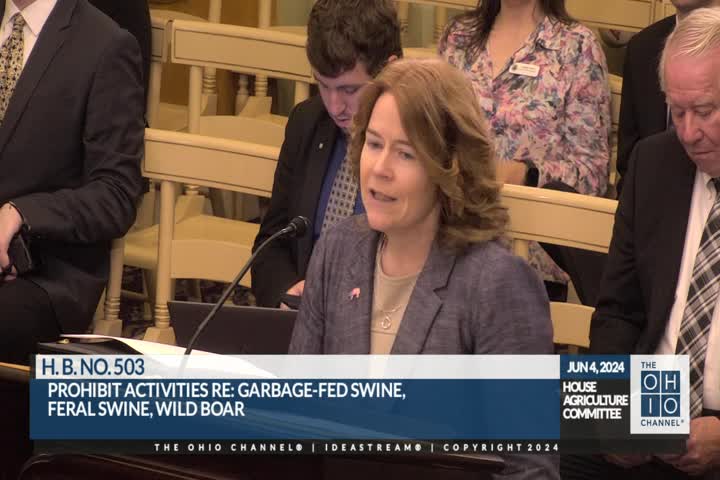Ohio takes decisive action against invasive feral swine threat
June 04, 2024 | Agriculture, House of Representatives, Committees, Legislative, Ohio

This article was created by AI summarizing key points discussed. AI makes mistakes, so for full details and context, please refer to the video of the full meeting. Please report any errors so we can fix them. Report an error »

In a recent government meeting, officials discussed the urgent need for House Bill 503, aimed at combating the invasive feral swine population in Ohio. These non-native animals pose a significant threat to the state's agricultural sector, particularly pork production, by spreading diseases and damaging land, crops, and water resources.
The bill seeks to prohibit the importation and hunting of feral swine and to end the controversial practice of garbage feeding, which has been linked to disease transmission. According to the U.S. Department of Wildlife Services, the economic losses from feral swine damage in the U.S. exceed $1.5 billion annually. The potential introduction of foreign animal diseases, such as African swine fever (ASF) and foot and mouth disease, raises the stakes even higher, with experts warning that an outbreak could devastate Ohio's pork industry and related agricultural sectors.
The testimony highlighted the proximity of ASF, currently reported just 800 miles away in the Dominican Republic, and its presence in 50 pork-producing countries. If ASF were to enter the U.S., it could lead to a drastic drop in hog prices—by as much as 60%—and severely impact farm families and the broader economy. Recovery from such an outbreak could take between two to ten years, a timeline that many farms cannot withstand.
The discussion also included insights from other states and countries that have faced similar challenges. In states with uncontrolled feral swine populations, taxpayers have spent millions on eradication efforts. A representative shared experiences from European countries, emphasizing the critical lesson learned: failure to manage feral swine can lead to catastrophic economic consequences.
As the committee deliberates on House Bill 503, the call for action is clear: proactive measures are essential to protect Ohio's farms, jobs, and natural resources from the looming threat of invasive species and foreign animal diseases.
The bill seeks to prohibit the importation and hunting of feral swine and to end the controversial practice of garbage feeding, which has been linked to disease transmission. According to the U.S. Department of Wildlife Services, the economic losses from feral swine damage in the U.S. exceed $1.5 billion annually. The potential introduction of foreign animal diseases, such as African swine fever (ASF) and foot and mouth disease, raises the stakes even higher, with experts warning that an outbreak could devastate Ohio's pork industry and related agricultural sectors.
The testimony highlighted the proximity of ASF, currently reported just 800 miles away in the Dominican Republic, and its presence in 50 pork-producing countries. If ASF were to enter the U.S., it could lead to a drastic drop in hog prices—by as much as 60%—and severely impact farm families and the broader economy. Recovery from such an outbreak could take between two to ten years, a timeline that many farms cannot withstand.
The discussion also included insights from other states and countries that have faced similar challenges. In states with uncontrolled feral swine populations, taxpayers have spent millions on eradication efforts. A representative shared experiences from European countries, emphasizing the critical lesson learned: failure to manage feral swine can lead to catastrophic economic consequences.
As the committee deliberates on House Bill 503, the call for action is clear: proactive measures are essential to protect Ohio's farms, jobs, and natural resources from the looming threat of invasive species and foreign animal diseases.
View full meeting
This article is based on a recent meeting—watch the full video and explore the complete transcript for deeper insights into the discussion.
View full meeting
